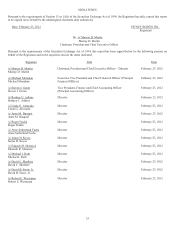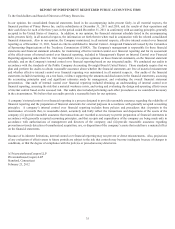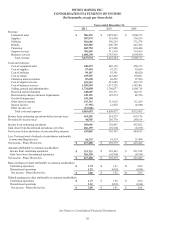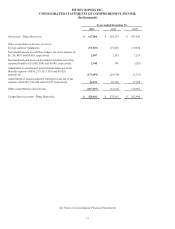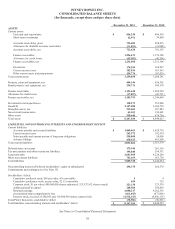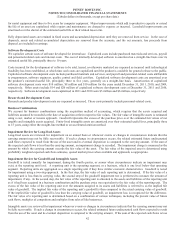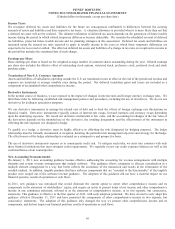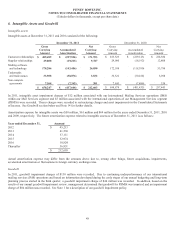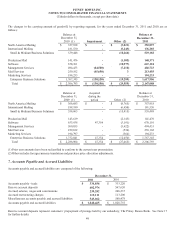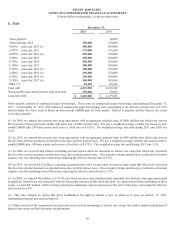Pitney Bowes 2011 Annual Report Download - page 59
Download and view the complete annual report
Please find page 59 of the 2011 Pitney Bowes annual report below. You can navigate through the pages in the report by either clicking on the pages listed below, or by using the keyword search tool below to find specific information within the annual report.PITNEY BOWES INC.
NOTES TO CONSOLIDATED FINANCIAL STATEMENTS
(Tabular dollars in thousands, except per share data)
41
1. Description of Business and Summary of Significant Accounting Policies
Description of Business & Basis of Presentation
We are a global provider of software, hardware and services to enable both physical and digital communications and to integrate those
physical and digital communications channels. We offer a full suite of equipment, supplies, software, services and solutions for
managing and integrating physical and digital communication channels. We conduct our business activities in seven reporting
segments within two business groups: Small & Medium Business Solutions and Enterprise Business Solutions. See Note 18 for
information regarding our reportable segments.
The accompanying financial statements have been prepared in conformity with accounting principles generally accepted in the United
States of America (GAAP). Operating results of acquired companies are included in the consolidated financial statements from the
date of acquisition. Intercompany transactions and balances have been eliminated. Certain prior year amounts have been reclassified
to conform to the current year presentation.
Use of Estimates
The preparation of our financial statements in conformity with GAAP requires the use of estimates and assumptions that affect the
reported amounts of assets, liabilities, revenues, expenses and accompanying disclosures, including the disclosure of contingent assets
and liabilities. These estimates and assumptions are based on management’s best knowledge of current events, historical experience,
and other information available when the financial statements are prepared. These estimates include, but are not limited to, revenue
recognition for multiple element arrangements, allowance for doubtful accounts and credit losses, residual values of leased assets,
useful lives of long-lived assets and intangible assets, goodwill and intangible asset impairment review, allocation of purchase price to
net assets acquired in business combinations, restructuring costs, pensions and other postretirement benefits and loss contingencies.
Actual results could differ from those estimates and assumptions.
Cash Equivalents and Short-Term Investments
Cash equivalents include short-term, highly liquid investments with maturities of three months or less at the date of purchase. Short-
term investments include highly liquid investments with a maturity of greater than three months but less than one year from the
reporting date.
Accounts Receivable and Allowance for Doubtful Accounts
We estimate our accounts receivable risks and provide allowances for doubtful accounts accordingly. We believe that credit risk for
accounts receivable is limited because of our large number of customers, small account balances for most of our customers and
customer geographic and industry diversification. We evaluate the adequacy of the allowance for doubtful accounts based on
historical loss experience, length of time receivables are past due, adverse situations that may affect a customer’s ability to pay and
prevailing economic conditions, and make adjustments to the reserves as necessary. This evaluation is inherently subjective and
actual results may differ significantly from estimated reserves.
Finance Receivable and Allowance for Credit Losses
Finance receivables are composed of sales-type lease receivables and unsecured revolving loan receivables. We estimate our finance
receivable risks and provide allowances for credit losses accordingly. We establish credit approval limits based on the credit quality
of the customer and the type of equipment financed. We believe that our concentration of credit risk is limited because of our large
number of customers, small account balances for most of our customers and customer geographic and industry diversification.
Our policy is to discontinue revenue recognition for lease receivables that are more than 120 days past due and for unsecured loan
receivables that are more than 90 days past due. We resume revenue recognition when customer payments reduce the account balance
aging to 60 days or less past due. We evaluate the adequacy of the allowance for credit losses based on historical loss experience, the
nature and volume of our portfolios, adverse situations that may affect a customer’s ability to pay and prevailing economic conditions,
and make adjustments to the reserves as necessary. This evaluation is inherently subjective and actual results may differ significantly
from estimated reserves.
Inventories
Inventories are stated at the lower of cost or market. Cost is determined on the last-in, first-out (LIFO) basis for most U.S. inventories,
and on the first-in, first-out (FIFO) basis for most non-U.S. inventories.
Fixed Assets and Depreciation
Property, plant and equipment and rental equipment are stated at cost and depreciated principally using the straight-line method over
their estimated useful lives, which are up to 50 years for buildings, three to 15 years for machinery and equipment, four to six years




